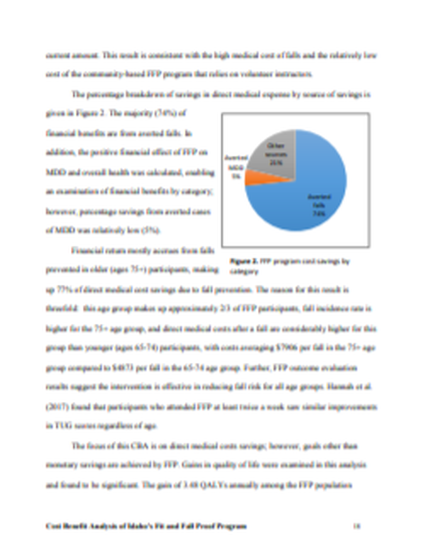
Falls are common among the elderly population. Almost 30% of Idahoans aged 65+ fall at least one time per year (Bergen, Stevens, & Burns, 2016). Falls are a significant source of morbidity, mortality, and healthcare expense. Fall-related injuries often result in expensive hospitalizations with progression into costly long-term care facilities (CDC, 2015). In Idaho, estimated fall-related medical costs are estimated at $253 million annually (CDC, 2016; Mirel & Carper, 2014).
Fit and Fall ProofTM (FFP), is a fall prevention program serving approximately 2500 community dwelling seniors throughout the state of Idaho. It is an exercise program led by peer volunteer instructors incorporating evidence-based methods of reducing the risk of falls. In addition to fall prevention, exercise programs such as FFP have well-established positive benefits on mental health, obesity rates, diabetes, and cardio-vascular health. All of these health benefits translate to savings in healthcare expense.
This cost benefit analysis (CBA) of FFP estimates savings in total direct medical costs of participants, and also calculates the portion of savings due to averted falls and averted cases of major depressive disorder (MDD). The CBA adopts a societal perspective, incorporating all sources of funding, both federal and state. In a similar way, all savings in direct medical costs are included in the analysis whether these cost-savings accrue to Medicare, Medicaid, private insurers, or FFP participants themselves. Due to the community-based nature of the intervention and privacy considerations, there is no information available on falls and related medical costs among FFP participants. Therefore, this CBA relies on modeled data obtained from other studies; however, conservative estimates of program efficacy and base fall incidence rates were employed. All costs were adjusted for medical inflation to 2016 dollars.
This document was originally published by Boise State University. Copyright restrictions may apply.
Available at: http://works.bepress.com/sarah_toevs/14/

Erratum: Discrepancies found in two tables of the first edition of this report. These errors are corrected and the second edition uploaded to this record.